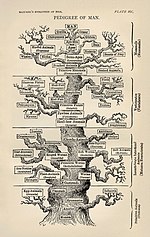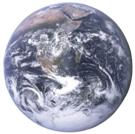|
The Devonian (/dəˈvoʊni.ən, dɛ-/ də-VOH-nee-ən, deh-) is a geologic period and system of the Paleozoic era during the Phanerozoic eon, spanning 60.3 million years from the end of the preceding Silurian period at 419.2 million years ago (Ma), to the beginning of the succeeding Carboniferous period at 358.9 Ma. It is named after Devon, South West England, where rocks from this period were first studied. The first significant evolutionary radiation of life on land occurred during the Devonian, as free-sporing land plants (pteridophytes) began to spread across dry land, forming extensive coal forests which covered the continents. By the middle of the Devonian, several groups of vascular plants had evolved leaves and true roots, and by the end of the period the first seed-bearing plants (pteridospermatophytes) appeared. This rapid evolution and colonization process, which had begun during the Silurian, is known as the Silurian-Devonian Terrestrial Revolution. The earliest land animals, predominantly arthropods such as myriapods, arachnids and hexapods, also became well-established early in this period, after beginning their colonization of land at least from the Ordovician period. (Full article...)
The geology of Somerset refers to the study of the structure, composition and history of the rocks in Somerset, a rural county in the southwest of England. Somerset covers4,171 square kilometres (1,610 sq mi). It is bounded on the north-west by the Bristol Channel, on the north by Bristol and Gloucestershire, on the north-east by Wiltshire, on the south-east by Dorset, and on the south west and west by Devon. It has broad central plains with several ranges of low hills. The landscape divides into four main geological sections from the Silurian through the Devonian and Carboniferous to the Permian which influence the landscape, together with water-related features.
The low lying areas of the North Somerset Levels and Somerset Levels have been subject to thousands of years of flooding and man's attempts to control the flow of water. In the north of the county the Limestone of the Mendip Hills dominates the landscape, while in the south the Blackdown and Quantock Hills rise out of the levels. The highest areas are on Exmoor. The wide variety of landscapes has led to several areas being designated as Sites of Special Scientific Interest for geological reasons, and support a range of flora and fauna as can be seen from the List of Sites of Special Scientific Interest in Somerset (see more...) 
Do you have a question about Abyssal/Portal:Devonian that you can't find the answer to? Consider asking it at the Wikipedia reference desk.
 In 1858, Charles Darwin and Alfred Russel Wallace published a new evolutionary theory that was explained in detail in Darwin's On the Origin of Species (1859). Unlike Lamarck, Darwin proposedcommon descent and a branching tree of life. The theory was based on the idea of natural selection, and it synthesized a broad range of evidence from animal husbandry, biogeography, geology, morphology, and embryology. The debate over Darwin's work led to the rapid acceptance of the general concept of evolution, but the specific mechanism he proposed, natural selection, was not widely accepted until it was revived by developments in biology that occurred during the 1920s through the 1940s. Before that time most biologists argued that other factors were responsible for evolution. The synthesis of natural selection with Mendelian genetics during the 1920s and 1930s founded the new discipline of population genetics. Throughout the 1930s and 1940s, population genetics became integrated with other biological fields, resulting in a widely applicable theory of evolution that encompassed much of biology—the modern evolutionary synthesis. (see more...) Epochs - Early Devonian - Middle Devonian - Late Devonian Landmasses - Baltica - Laurentia - Euramerica - Gondwana Fossil sites - Grenfell fossil site History - The Great Devonian Controversy Featured Devonian articles - None The following Wikimedia Foundation sister projects provide more on this subject:
|




















